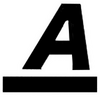Engineering:A Scow
 | |
| Development | |
|---|---|
| Designer | John O. Johnson |
| Location | United States |
| Year | 1901 |
| Builder(s) | Johnson Boat Works Melges Performance Sailboats |
| Role | racer |
| Boat | |
| Crew | at least five |
| Boat weight | 1,850 lb (839 kg) |
| Draft | 4.00 ft (1.22 m) with a centerboard down |
| Hull | |
| Type | monohull |
| Construction | wood or fiberglass |
| LOA | 38.00 ft (11.58 m) |
| Beam | 8.25 ft (2.51 m) |
| Hull appendages | |
| Keel/board type | dual centerboards |
| Rudder(s) | dual, spade-type rudders |
| Rig | |
| Rig type | Bermuda rig |
| Sails | |
| Sailplan | fractional rigged sloop |
| Mainsail area | 350 sq ft (33 m2) |
| Jib/genoa area | 150 sq ft (14 m2) |
| Spinnaker area | 1,200 sq ft (110 m2) |
| Total sail area | 500 sq ft (46 m2) |
The A Scow is an American scow-hulled sailing dinghy that was designed by John O. Johnson as a racer and first built in 1901.[1]
The A Scow design was developed into the V38, by Victory by Design, LLC in 2005.[2]
Production
The design was initially built by Johnson Boat Works in White Bear Lake, Minnesota United States , but that company closed in 1998 and production passed to Melges Performance Sailboats, who continue to build it.[1][3][4][5]
Design
The A Scow traces its origins back to a Johnson-designed prototype in 1896. Over time the class has changed and evolved into essentially a one design class today. At 38.00 ft (11.58 m) length overall, the design is the largest scow raced today and is one of the largest dinghies produced.[1]
The A Scow is a racing sailboat, with the early versions built from wood and the more recent ones built predominantly of fiberglass. It has a fractional sloop with a masthead spinnaker. The hull is a scow design with a raised counter, vertical transom; dual spade-type rudders controlled by dual tillers and dual retractable centerboards. It displaces 1,850 lb (839 kg) and carries no ballast.[1]
The boat has a draft of 4.00 ft (1.22 m) with a centerboard extended and 1.00 ft (0.30 m) with both retracted, allowing beaching or ground transportation on a trailer.[1]
For sailing the design is equipped with an asymmetrical spinnaker of 1,200 sq ft (110 m2), flown from a retractable bowsprit.[1]
The design is raced with a crew of at least five sailors and normally has a total of six or seven crew members to help balance the boat.[5]
Operational history
The boat is supported by a national class club, the National Class A Scow Association, which regulates the class and organizes races.[6] The A Scow is mostly raced on lakes in the midwestern United States.[1]
A film was made about racing A Scows, The Ultimate Ride, by racer Peter Crawford.[7]
A review in Sailing World in 2006 by Gary Jobson, wrote, "these boats sail best when heeled more than 20 degrees, and in a breeze, it takes a lot of courage to do this. The boat rocks up and you feel as if you're about to be catapulted out of the cockpit. But a subtle tug on the tiller, a slight ease of the main and spinnaker sheets, and zingo, you're sailing at 25 knots. There's no crew weight limit, so depending on the wind strength, 5 to 7 crew can be piled on the rail with sailors rotating on or off in between races."[7]
See also
References
- ↑ 1.0 1.1 1.2 1.3 1.4 1.5 1.6 McArthur, Bruce (2020). "A Scow sailboat". sailboatdata.com. https://sailboatdata.com/sailboat/a-scow.
- ↑ Victory by Design, LLC. "Design Story". victorybydesign.org. http://www.victorybydesign.org/design-story.
- ↑ McArthur, Bruce (2020). "Melges Performance Sailboats". sailboatdata.com. https://sailboatdata.com/builder/melges-performance-sailboats.
- ↑ McArthur, Bruce (2020). "Johnson Boat Works (USA) 1896 - 1998". sailboatdata.com. https://sailboatdata.com/builder/johnson-boat-works-usa.
- ↑ 5.0 5.1 Melges Performance Sailboats (2020). "The Melges A Scow". melges.com. https://melges.com/melges-a-scow/.
- ↑ McArthur, Bruce (2020). "National Class A Scow Association". sailboatdata.com. https://sailboatdata.com/association/national-class-a-scow-association.
- ↑ 7.0 7.1 Jobson, Gary (4 October 2006). "The Ultimate Ride, Indeed". Sailing World. https://www.sailingworld.com/racing/ultimate-ride-indeed/.
External links
 |

